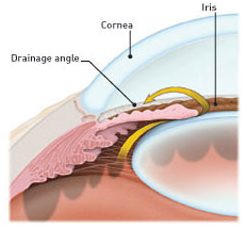Ocular hypertension is the term used to describe any situation in which pressure inside the eye(s) is higher than normal but without any changes in vision or damage to the eye structure. Ocular hypertension1 itself is not considered a disease, but rather an indication that the individual should be more closely monitored for the onset of glaucoma, a serious disease that damages the optic nerve and causes vision loss and blindness.

A person with ocular hypertension does not have any noticeable signs or symptoms of the condition. As such, it is important to have regular eye exams, during which your ophthalmologist or optometrist will measure the pressure in your eyes using a tonometer and examine your eyes. If someone in your family has this condition, it is especially important for you to have your eyes checked as this condition can run in the family.
Ocular hypertension2 can be caused by genetics, certain eye diseases, injury to the eye and some medications. Certain groups of people are at a higher risk for high eye pressure. These include:
A clear link between ocular hypertension and glaucoma has been established. Individuals with elevated eye pressure may go on to develop glaucoma or may already have glaucoma. For this reason, ophthalmologists use the term "glaucoma suspect" to refer to people with ocular hypertension.
Glaucoma is diagnosed when there are optic nerve damage and vision loss, in addition to ocular hypertension. Glaucoma can cause vision loss and even blindness, but with early intervention, the complications of glaucoma can be minimized. Studies have shown that early management of intraocular pressure is effective at slowing the onset and severity of glaucoma. For this reason, any sign of ocular hypertension is treated very seriously by our ophthalmologists.
When Ocular hypertension is suspected, our Orange County eye doctors will conduct a specialized examination of the eye. For ocular hypertension to be diagnosed, the following indications are usually present:
As part of the comprehensive eye examination performed at Beach Eye Medical Group, our eye doctors perform a number of tests to measure your intraocular pressure and ensure that you do not have glaucoma. These include:
This test measures the pressure in your eyes. First, numbing eye drops are applied. Then a tonometer is used to measure how the cornea resists pressure, which provides a measurement of eye pressure.
Gonioscopy helps us determine if the eye's drainage system (called the "angle") is open or closed. Using a special mirrored contact lens, the ophthalmologist can examine the drainage angle, which is a key factor in determining whether glaucoma is present.
During this portion of the exam, our ophthalmologist inspects the optic nerve for any signs of damage using an ophthalmoscope to magnify the interior of the eye. Dilating eye drops will be used to widen the pupil to give the doctor a better view of the optic nerve.
The visual field test is used to gauge the health of the patient's peripheral (side) vision using an instrument called a perimeter. The test looks for blank spots in peripheral vision, which are another sign of glaucoma.
A probe called a pachymeter is placed on the cornea to measure corneal thickness. This test is performed because the thickness of the cornea can influence eye pressure. Corneal thickness measurements provide the ophthalmologist with a more accurate idea of overall eye health.
Optical Coherence Tomography3 provides very detailed pictures of the optic nerve. When a series of these pictures are captured over time, they can be particularly helpful in determining whether glaucoma is stable or becoming worse. Not all eye care practices offer OCT imagining as a part of their comprehensive exam or use the latest equipment. At Beach Eye Medical Group, we have invested in the Cirrus HD Spectral Domain OCT, the latest, most advanced imaging equipment, to help us better monitor ocular hypertension and glaucoma.
While ocular hypertension does not always require immediate treatment, it is important that individuals with high eye pressure are monitored closely so that it does not cause vision loss or damage to the optic nerve.
The decision to initiate treatment to reduce high eye pressure will be based upon the patient's level of intraocular pressure and unique medical history. If our ophthalmologist determines that medication is required, pressure-lowering eye drops may be prescribed. In certain cases, more than one medication may be prescribed. When a new medication is being used, the patient will be asked to visit the office for regular eye pressure checks to determine if the medication is effective.
Because many people with ocular hypertension go on to develop glaucoma4, it is very important that patients with high eye pressure follow through with regular eye exams. If glaucoma does eventually develop, medical intervention is required to lower intraocular pressure and prevent further damage. At Beach Eye Medical Group, we offer all the latest glaucoma treatments, including eye drops, laser treatment, or surgery.
References
1 What Is Ocular Hypertension? Available: https://www.aao.org/eye-health/diseases/what-is-ocular-hypertension
2 Types of Migraine Headaches. Available: https://www.webmd.com/migraines-headaches/migraines-headaches-migraines
3 What Is Optical Coherence Tomography? Available: https://www.aao.org/eye-health/treatments/what-is-optical-coherence-tomography
4 Glaucoma. Available: https://www.nei.nih.gov/learn-about-eye-health/eye-conditions-and-diseases/glaucoma
The Doctors, Assistants and Staff are all very professional, knowledgeable, helpful and kind. They all together made me feel confident that all my questions and needs were addressed. Love this office!